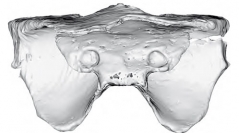

 Geodiversitas
32 (4) - Pages 595-661
Geodiversitas
32 (4) - Pages 595-661Recent gnathostomes are composed of two major clades, the chondrichthyans, or cartilaginous fishes, and the osteichthyans, or bony fishes and tetrapods. Recent chondrichthyans include about 1200 elasmobranch (sharks and rays) species, but only about 40 holocephalan (ratfish) species. Nevertheless, an important radiation of chondrichthyans took place in the Carboniferous (360-300 Myr), and gave rise to an important diversity of odd and poorly understood taxa, such as the inio pterygians, that are considered as related to extant holocephalans. However, the relationships between these taxa and the two extant chondrichthyan clades remain controversial. Th e material studied here by means of computed microtomography scanning using synchrotron radiation X-ray, consists of neurocrania from the Upper Carboniferous of Kansas and Oklahoma (USA), which are remarkably well preserved in three dimensions, and which belong to one of the two families of inio pterygians, the Sibyrhynchidae Zangerl & Case, 1973. A detailed description of these specimens provides more information about the cranial and brain anatomy of this taxon. No three-dimensionally preserved skull of any stem-holocephalan was known in detail to date, contrary to fossil elasmobranchs. The data presented here show the three-dimensionally preserved braincase of a possible stem-holocephalan as these new specimens share with extant chimaeroids some key neurocranial characters. This may provide means for a comparative study of skull anatomy in Paleozoic representatives of the main two chondrichthyan clades.
Chondrichthyes, Iniopterygia, Sibyrhynchidae, gnathostomes, holocephalans, neurocranium, brain, Paleozoic, Synchrotron, X-ray, USA